GMC SIERRA 1999 User Guide
Manufacturer: GMC, Model Year: 1999, Model line: SIERRA, Model: GMC SIERRA 1999Pages: 440, PDF Size: 2.94 MB
Page 11 of 440
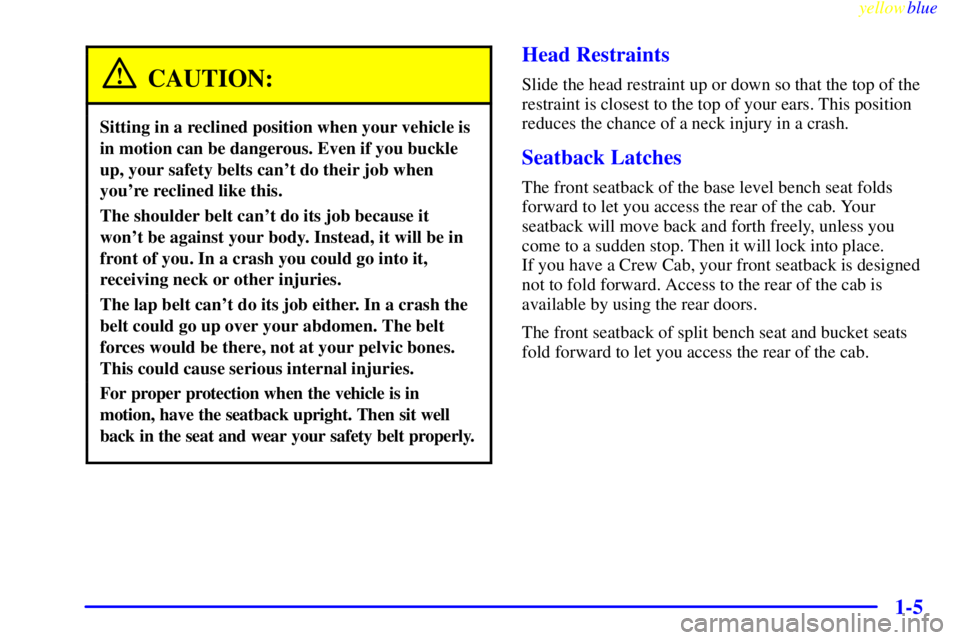
yellowblue
1-5
CAUTION:
Sitting in a reclined position when your vehicle is
in motion can be dangerous. Even if you buckle
up, your safety belts can't do their job when
you're reclined like this.
The shoulder belt can't do its job because it
won't be against your body. Instead, it will be in
front of you. In a crash you could go into it,
receiving neck or other injuries.
The lap belt can't do its job either. In a crash the
belt could go up over your abdomen. The belt
forces would be there, not at your pelvic bones.
This could cause serious internal injuries.
For proper protection when the vehicle is in
motion, have the seatback upright. Then sit well
back in the seat and wear your safety belt properly.
Head Restraints
Slide the head restraint up or down so that the top of the
restraint is closest to the top of your ears. This position
reduces the chance of a neck injury in a crash.
Seatback Latches
The front seatback of the base level bench seat folds
forward to let you access the rear of the cab. Your
seatback will move back and forth freely, unless you
come to a sudden stop. Then it will lock into place.
If you have a Crew Cab, your front seatback is designed
not to fold forward. Access to the rear of the cab is
available by using the rear doors.
The front seatback of split bench seat and bucket seats
fold forward to let you access the rear of the cab.
Page 12 of 440
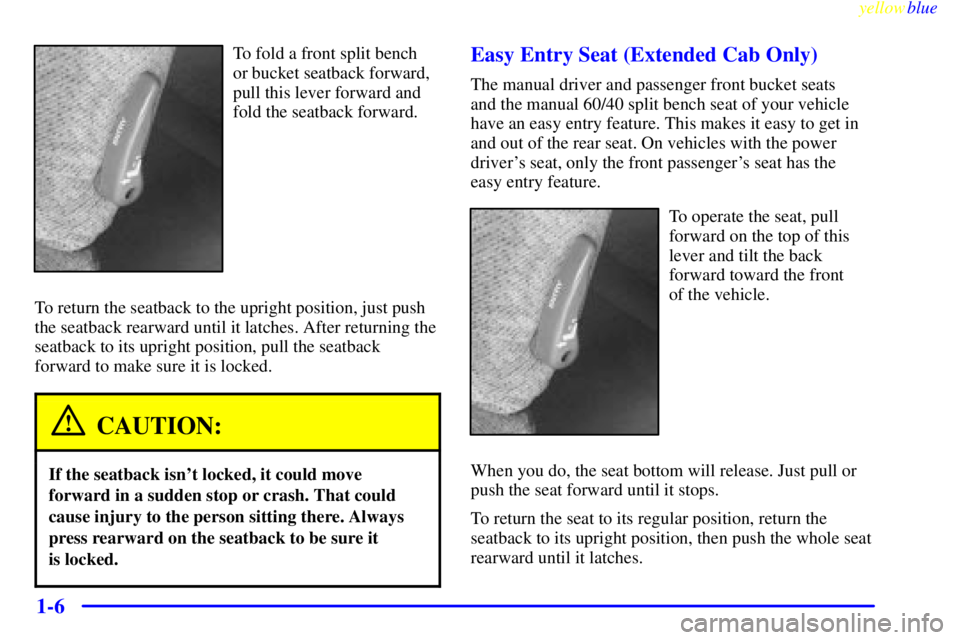
yellowblue
1-6
To fold a front split bench
or bucket seatback forward,
pull this lever forward and
fold the seatback forward.
To return the seatback to the upright position, just push
the seatback rearward until it latches. After returning the
seatback to its upright position, pull the seatback
forward to make sure it is locked.
CAUTION:
If the seatback isn't locked, it could move
forward in a sudden stop or crash. That could
cause injury to the person sitting there. Always
press rearward on the seatback to be sure it
is locked.
Easy Entry Seat (Extended Cab Only)
The manual driver and passenger front bucket seats
and the manual 60/40 split bench seat of your vehicle
have an easy entry feature. This makes it easy to get in
and out of the rear seat. On vehicles with the power
driver's seat, only the front passenger's seat has the
easy entry feature.
To operate the seat, pull
forward on the top of this
lever and tilt the back
forward toward the front
of the vehicle.
When you do, the seat bottom will release. Just pull or
push the seat forward until it stops.
To return the seat to its regular position, return the
seatback to its upright position, then push the whole seat
rearward until it latches.
Page 13 of 440
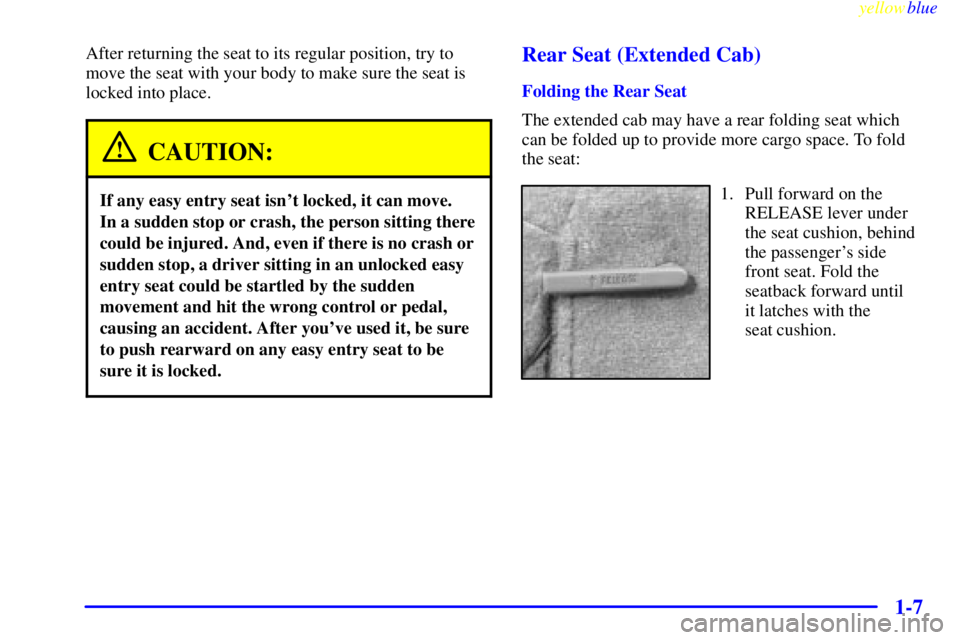
yellowblue
1-7
After returning the seat to its regular position, try to
move the seat with your body to make sure the seat is
locked into place.
CAUTION:
If any easy entry seat isn't locked, it can move.
In a sudden stop or crash, the person sitting there
could be injured. And, even if there is no crash or
sudden stop, a driver sitting in an unlocked easy
entry seat could be startled by the sudden
movement and hit the wrong control or pedal,
causing an accident. After you've used it, be sure
to push rearward on any easy entry seat to be
sure it is locked.
Rear Seat (Extended Cab)
Folding the Rear Seat
The extended cab may have a rear folding seat which
can be folded up to provide more cargo space. To fold
the seat:
1. Pull forward on the
RELEASE lever under
the seat cushion, behind
the passenger's side
front seat. Fold the
seatback forward until
it latches with the
seat cushion.
Page 14 of 440
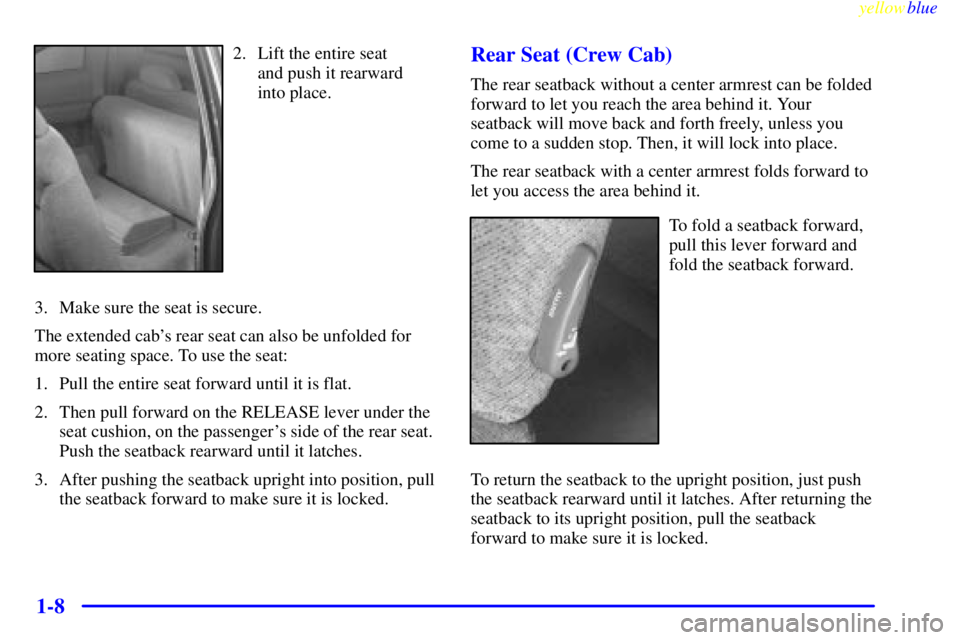
yellowblue
1-8
2. Lift the entire seat
and push it rearward
into place.
3. Make sure the seat is secure.
The extended cab's rear seat can also be unfolded for
more seating space. To use the seat:
1. Pull the entire seat forward until it is flat.
2. Then pull forward on the RELEASE lever under the
seat cushion, on the passenger's side of the rear seat.
Push the seatback rearward until it latches.
3. After pushing the seatback upright into position, pull
the seatback forward to make sure it is locked.Rear Seat (Crew Cab)
The rear seatback without a center armrest can be folded
forward to let you reach the area behind it. Your
seatback will move back and forth freely, unless you
come to a sudden stop. Then, it will lock into place.
The rear seatback with a center armrest folds forward to
let you access the area behind it.
To fold a seatback forward,
pull this lever forward and
fold the seatback forward.
To return the seatback to the upright position, just push
the seatback rearward until it latches. After returning the
seatback to its upright position, pull the seatback
forward to make sure it is locked.
Page 15 of 440
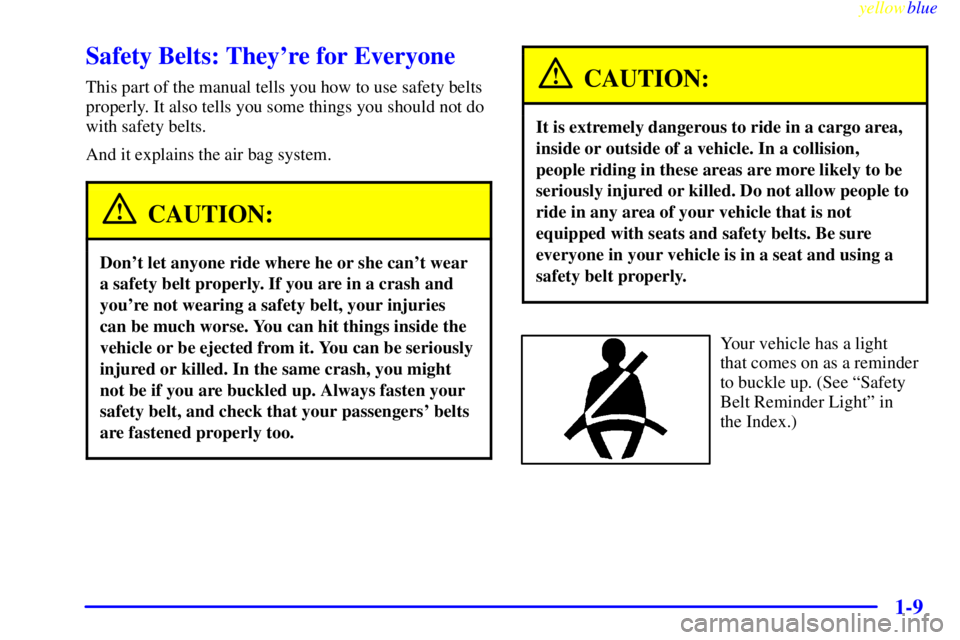
yellowblue
1-9
Safety Belts: They're for Everyone
This part of the manual tells you how to use safety belts
properly. It also tells you some things you should not do
with safety belts.
And it explains the air bag system.
CAUTION:
Don't let anyone ride where he or she can't wear
a safety belt properly. If you are in a crash and
you're not wearing a safety belt, your injuries
can be much worse. You can hit things inside the
vehicle or be ejected from it. You can be seriously
injured or killed. In the same crash, you might
not be if you are buckled up. Always fasten your
safety belt, and check that your passengers' belts
are fastened properly too.
CAUTION:
It is extremely dangerous to ride in a cargo area,
inside or outside of a vehicle. In a collision,
people riding in these areas are more likely to be
seriously injured or killed. Do not allow people to
ride in any area of your vehicle that is not
equipped with seats and safety belts. Be sure
everyone in your vehicle is in a seat and using a
safety belt properly.
Your vehicle has a light
that comes on as a reminder
to buckle up. (See ªSafety
Belt Reminder Lightº in
the Index.)
Page 16 of 440
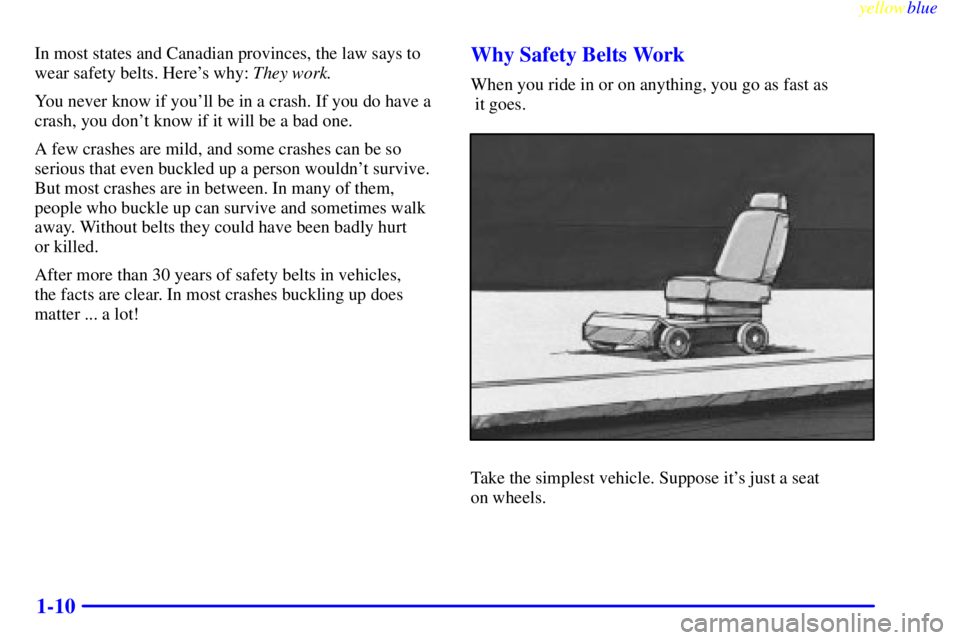
yellowblue
1-10
In most states and Canadian provinces, the law says to
wear safety belts. Here's why: They work.
You never know if you'll be in a crash. If you do have a
crash, you don't know if it will be a bad one.
A few crashes are mild, and some crashes can be so
serious that even buckled up a person wouldn't survive.
But most crashes are in between. In many of them,
people who buckle up can survive and sometimes walk
away. Without belts they could have been badly hurt
or killed.
After more than 30 years of safety belts in vehicles,
the facts are clear. In most crashes buckling up does
matter ... a lot!Why Safety Belts Work
When you ride in or on anything, you go as fast as
it goes.
Take the simplest vehicle. Suppose it's just a seat
on wheels.
Page 17 of 440
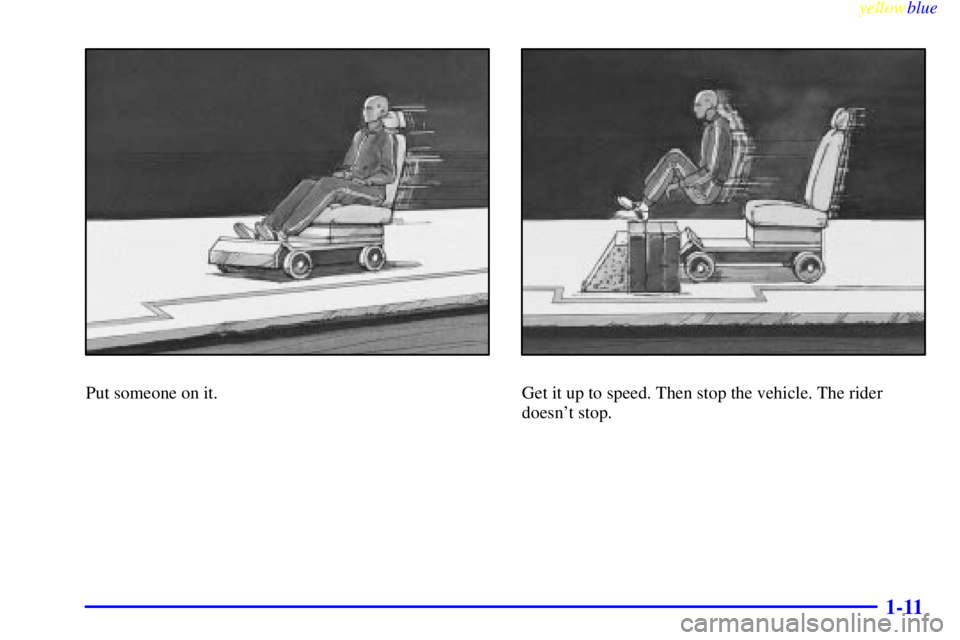
yellowblue
1-11
Put someone on it.Get it up to speed. Then stop the vehicle. The rider
doesn't stop.
Page 18 of 440
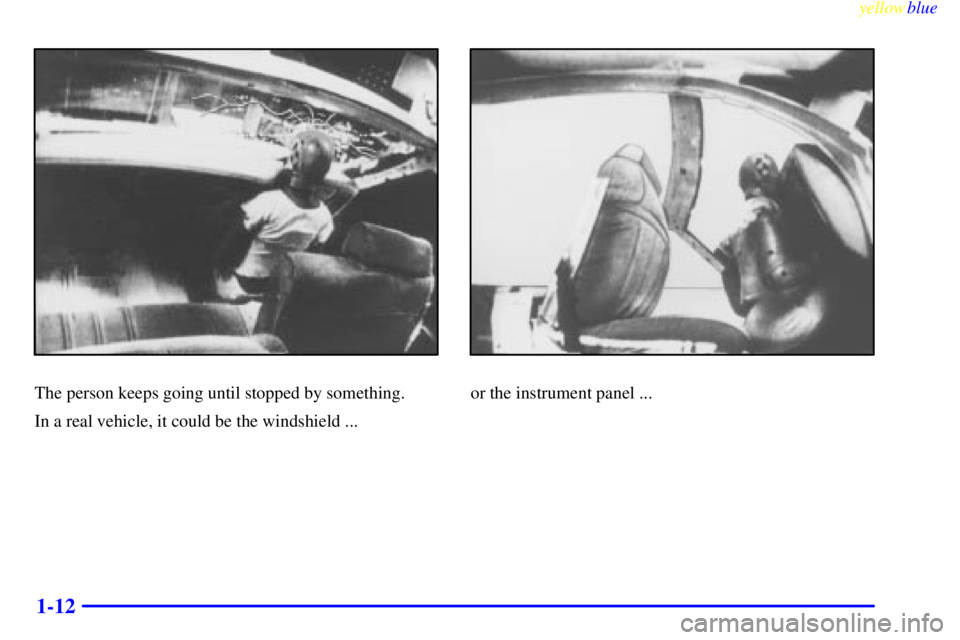
yellowblue
1-12
The person keeps going until stopped by something.
In a real vehicle, it could be the windshield ...or the instrument panel ...
Page 19 of 440
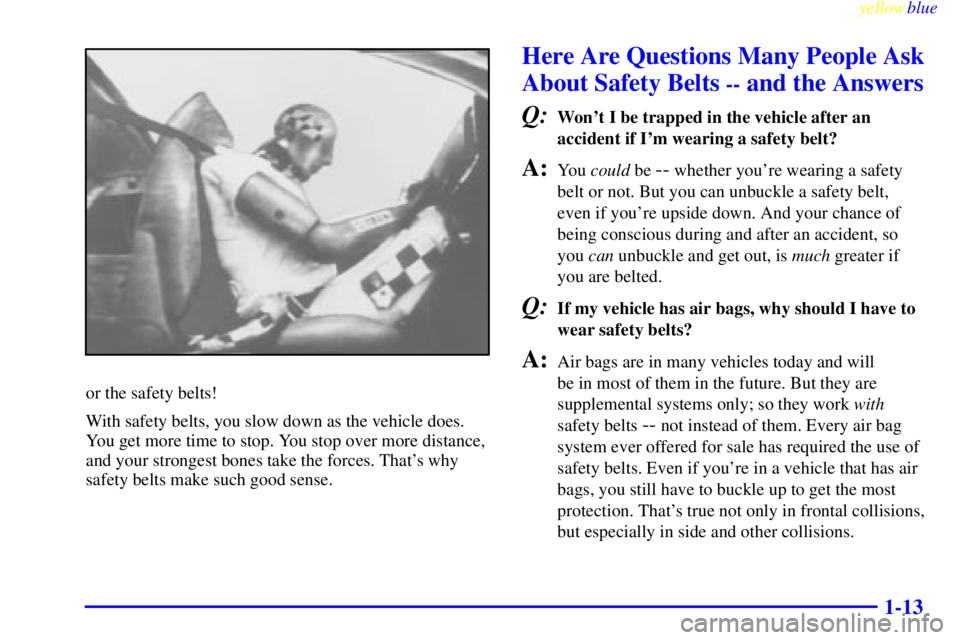
yellowblue
1-13
or the safety belts!
With safety belts, you slow down as the vehicle does.
You get more time to stop. You stop over more distance,
and your strongest bones take the forces. That's why
safety belts make such good sense.
Here Are Questions Many People Ask
About Safety Belts
-- and the Answers
Q:
Won't I be trapped in the vehicle after an
accident if I'm wearing a safety belt?
A:You could be -- whether you're wearing a safety
belt or not. But you can unbuckle a safety belt,
even if you're upside down. And your chance of
being conscious during and after an accident, so
you can unbuckle and get out, is much greater if
you are belted.
Q:If my vehicle has air bags, why should I have to
wear safety belts?
A:Air bags are in many vehicles today and will
be in most of them in the future. But they are
supplemental systems only; so they work with
safety belts
-- not instead of them. Every air bag
system ever offered for sale has required the use of
safety belts. Even if you're in a vehicle that has air
bags, you still have to buckle up to get the most
protection. That's true not only in frontal collisions,
but especially in side and other collisions.
Page 20 of 440
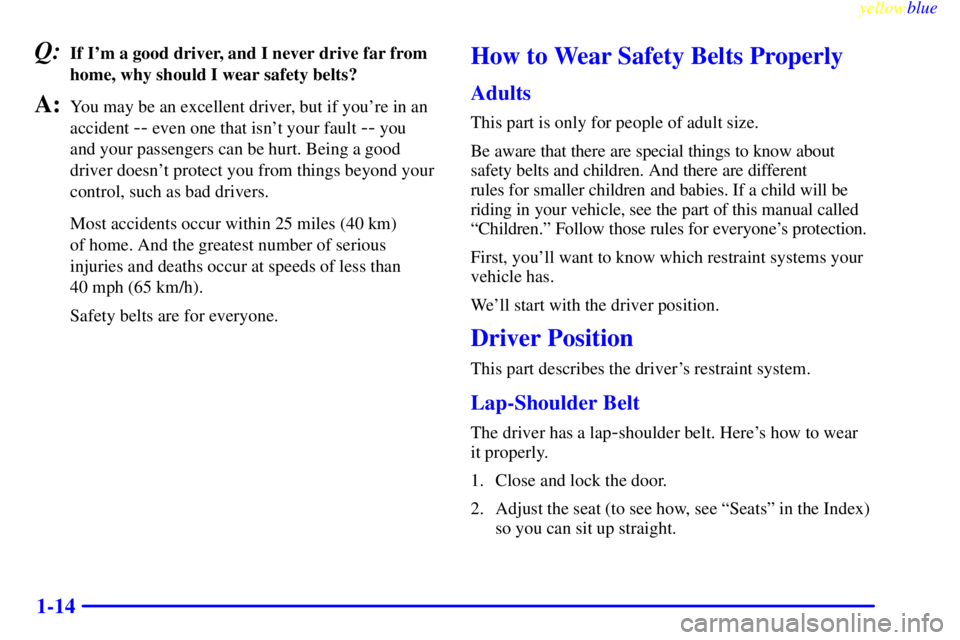
yellowblue
1-14
Q:If I'm a good driver, and I never drive far from
home, why should I wear safety belts?
A:You may be an excellent driver, but if you're in an
accident
-- even one that isn't your fault -- you
and your passengers can be hurt. Being a good
driver doesn't protect you from things beyond your
control, such as bad drivers.
Most accidents occur within 25 miles (40 km)
of home. And the greatest number of serious
injuries and deaths occur at speeds of less than
40 mph (65 km/h).
Safety belts are for everyone.
How to Wear Safety Belts Properly
Adults
This part is only for people of adult size.
Be aware that there are special things to know about
safety belts and children. And there are different
rules for smaller children and babies. If a child will be
riding in your vehicle, see the part of this manual called
ªChildren.º Follow those rules for everyone's protection.
First, you'll want to know which restraint systems your
vehicle has.
We'll start with the driver position.
Driver Position
This part describes the driver's restraint system.
Lap-Shoulder Belt
The driver has a lap-shoulder belt. Here's how to wear
it properly.
1. Close and lock the door.
2. Adjust the seat (to see how, see ªSeatsº in the Index)
so you can sit up straight.